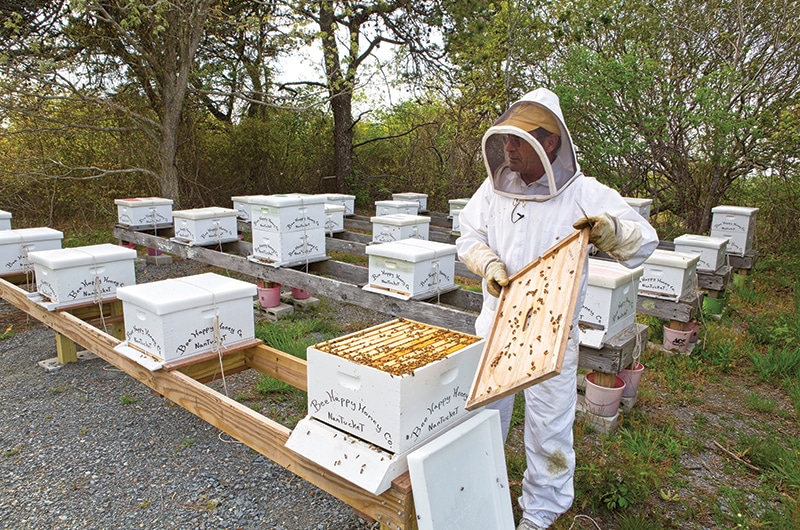by Cara Godlesky

What would you do if you no longer had access to your favorite fruits, vegetables, and nuts? We are thankful to get most of our produce because of the bee population. Without them, agriculture throughout the world would suffer. Apples, almonds, and avocados are just three popular foods that would disappear without bees and their pollination.
The loss in the bee population is making the role of beekeeping increasingly important. These backyard beekeepers, who manage 50 or fewer colonies, will aid in the comeback of the bee population. On Nantucket, we are blessed to have abundant food sources for the bees, such as the cranberry bogs, which can allow the insects to thrive.
“When I started beekeeping, it wasn’t too enticing because honey was only $1.50 a pound,” said Hitchcock. “You’d have to find other ways to make money or keep lots and lots bees.”
Now Hitchcock sells honey, bottled in the first American one pound honey bottle designed by Henry Muth in 1850, for $20 a pound. Honey from local sources has become more widely desired in recent years due to increasing support from communities and attention in the media surrounding the bee loss epidemic.
Over the course of the season, Hitchcock will harvest about 3,000 pounds of honey. He has about three million bees in his colonies, which are located on Windswept Cranberry Bogs and also at another location a mile and a half from Bartlett’s Farm. Hitchcock’s honey is unfiltered, unpasteurized, and pure.
Any large-scale honey producer or packer will get their honey from many different sources, and sometimes from sources outside of the US. The only way to be certain you are purchasing local honey is to buy if from a local beekeeper. Hitchcock not only uses the honey the bees produce, but the wax as well. He takes the beeswax and creates candles. He got into candle making because one day his daughter asked if they could do it together. He had no knowledge about it, but jumped on the opportunity to start something new. “I have the type of personality that I don’t say no to things. You might miss out on something fun,” said Hitchcock.
Beeswax is a much better product for candles than paraffin wax.
Beeswax burns longer and cleaner than candles made from other types of waxes. Hitchcock’s candles burn for up to six or thirteen hours, depending on their size.
In Europe during the 1400s, beeswax was such an important commodity that it was accepted as legal tender and could be used to pay taxes and rent. Only royalty, the wealthy, and the church were allowed to burn beeswax during that time. Today, beeswax candles are still valuable and can be pricey because of their efficiency and because there are very few naturally occurring sources of wax for candles besides from bees.
“[Apiculture is] fascinating and intriguing. It’s easy to do. In fact I chuckle over the number of people into beekeeping. You show someone a few fascinating points and they learn on their own and it cascades from there,” said Hitchcock. “It’s hard not to do it.”
Hitchcock says that one day he will give up his beekeeping and wishes to spend more time on the ocean and sailing instead. He hopes one day to pass on his hives to another aspiring apiarist.
“If some young person were to come along and really be enthused by it, I’d be happy to turn it over to them,” said Hitchcock.
Hitchcock wants to people to know that bees are nothing to be afraid of. However, the collapse of the bee colonies is something to fear. Bees are essential for pollination. Without them, our food sources would diminish. If you are wondering what you can do to support the bees, avoid spraying or killing hives or bees on your property, buy local honey, and vote to keep neighborhood beekeeping alive in your local town.
“I always felt as though since we got all this press [about bee colony collapse], people are nice to beekeepers. They are buying my products and appreciative and respect the honeybee,” said Hitchcock. “I find it really special.
All photos courtesy of Terry Pommett.